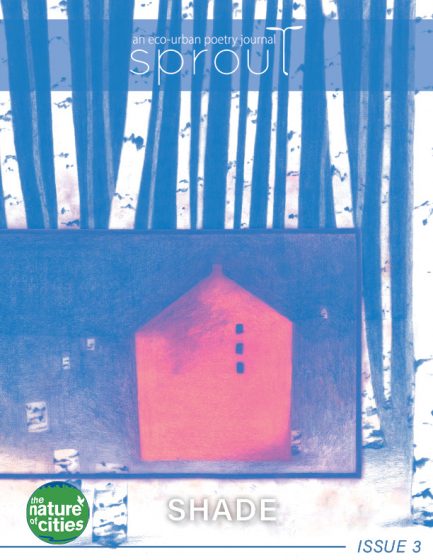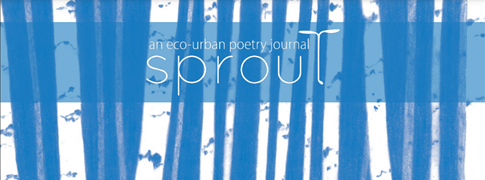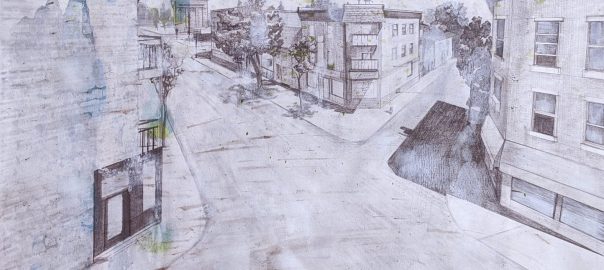For SPROUT’s third issue, the editors were inspired by The Nature of Cities’ (TNOC) recent art exhibition, Shade, and invited contributors to draw on the exhibition’s virtual installation as a conceptual springboard to contemplate the theme of shade through a poetic lens. We asked poets to reflect on the role shade plays in the built environment, particularly focusing on shade equity—i.e., how shade can make more inclusive spaces in the city, or, conversely, how the lack thereof can create inhospitable, hostile spaces. We were interested in soliciting work that considered shade from ecological, architectural, and environmental justice points of view.
In our first completely open call, we encouraged contributors to visit the virtual exhibit of TNOC’s Shade and wander through the installation of featured artists’ umbrellas (manifesting different interpretations of shade). Curated by community-based arts organisation, Arroyo Arts, the exhibition welcomed emerging and established artists to use repurposed umbrellas as their canvas to explore the themes of shade, heat, nature, and climate change. One of the prompts provided to guide visual artists for the Shade exhibit—which we, too, found helpful—read as follows:
In a warming world, shade equity is an issue that disproportionately affects low-income and working-class communities, people of color, and communities in developing nations who are more likely to work outdoors, rely on public transportation, and live in denser neighborhoods with a lack of trees and shade. As the climate changes and heat waves become longer, more intense, and more frequent, what was once thought primarily as an aesthetic amenity is increasingly recognized as a way of protecting the public health and well-being of marginalized communities. Urban heat causes more deaths than all other weather-related causes combined in an average year, and yet providing shade can be simple and effective and can be done in many creative ways including tree planting, bus stop sheds, and awnings, to name a few.
Our issue’s treatment of shade reveals poems that chart the course of light and dark (in other words, the movement of shade), through the course of the day. They play with the idea of how shade shifts and maps itself over urban (and some less urban) spaces. The issue begins with Jean Janicke’s poem inviting us to take action, asking us to put down what we’re doing and “Hurry” in order to not miss the sun lining up through the tree canopy in a transient moment where light communicates through the morse code of shade. Movement and the turning of the earth as light and dark alternate is then carried through to Adrienne Stevenson’s poem, “Degrees of Light”, which sustains the ambivalence of both time standing still, with the sun at its noon-day height, and then its corresponding advancement into the shaded violet of night.
 The heat of the day with its absence of shade appeared to interest a number of contributors and this is picked up further in Sue Woodward’s “standard bearer (dawn at eselfontein)”. The poem follows man and dog, walking from one farm to the next in the morning sun, as the shade spins around the axis of the man’s vertical form. He is a flagpole, casting a giant shadow over his dog, which (ignoring for a moment the immediate relief it must provide to his dog) haunts the page with anthropocentric significance: what shadow do we, as humans, cast over the natural world through our activities? Like the blistering sun the farmer faces, Heather Wishik’s diptych faces the topic of shade equity head on. In “Two Neighborhoods – 1960s Pittsburgh”, Wishik presents two urban portraits: one with shaded affluence juxtaposed against that of the workers’ treeless sidewalks that “burned children’s bare feet”.
The heat of the day with its absence of shade appeared to interest a number of contributors and this is picked up further in Sue Woodward’s “standard bearer (dawn at eselfontein)”. The poem follows man and dog, walking from one farm to the next in the morning sun, as the shade spins around the axis of the man’s vertical form. He is a flagpole, casting a giant shadow over his dog, which (ignoring for a moment the immediate relief it must provide to his dog) haunts the page with anthropocentric significance: what shadow do we, as humans, cast over the natural world through our activities? Like the blistering sun the farmer faces, Heather Wishik’s diptych faces the topic of shade equity head on. In “Two Neighborhoods – 1960s Pittsburgh”, Wishik presents two urban portraits: one with shaded affluence juxtaposed against that of the workers’ treeless sidewalks that “burned children’s bare feet”.
Mary Elizabeth Birnbaum’s “Burn” seems to present a timely message on this front (with its description of “seeded flame rooted rage”)—especially when forest fires and their attendant smoke and haze currently enshroud the northeastern seaboard of North America. Assuming a more transhistorical point of view, Gregory Haber’s “The South Bronx Sea” contemplates the impact of settler colonial urban planning with the Bronx’s lack of shade as a result of deforestation and industry: both “habitat and haven”, which had previously been “gifted” by “soft pine and hard hornbeam”, are now “sun-beat hardscapes” of “extirpated shade”. Not all is lost though, as “rebellious rebirth” of the forests start to “plumb concrete cracks”, seeing shade finally start to return to the city. Is this a way in which to begin remediating both nature and city of the harm engendered by mercantilist imperialism? What does this mean for its people?
This question seems to be taken up by the next two poems: Sihle Ntule’s “The Sunset Clause” and Erica Bartholomae’s “Heading Home”—both South African poets contemplating shade from a geopolitical perspective. These poems function dialogically, initiating conversation around the shade cast by the old dispensation of apartheid; both wondering whether the dawning of a new age is possible when the legacy of inequity runs so deep. Ntule’s poem throws shade, figuratively, by raising the spectre of South Africa’s fraught negotiated settlement in its transition to multiparty democracy (the “sunset clause” presenting a temporary power-sharing arrangement to end the political deadlock), whilst Bartholomae’s poem reflects how—through the conceit of shade inequity—very little has substantively changed in the country. The editors mulled over the choice of wording in the final lines of the poem: “Wondering how far she had to walk and if this country will ever / change” [our emphasis]. We found the use of the demonstrative pronoun (“this”) over the possible possessive determiner (“our”) interesting, and wondered what this could mean for the collective responsibility needed to overcome environmental racism. We invite our readers to allow themselves to be drawn into the world of this poem, and to sit with this discomfort.
In Anna Rowntree’s, “In the Shade of Some Newly Planted Thing”, a considered reflection on newness runs through the poem—“I didn’t think to bring a blanket; /I am new to this too”; “little walk to the park, the sort of thing new mothers do”—and with it, a sharp focus emerges on its opposite; the opposite here points to what is missing, what is absent, and it extends beyond the line, “But there are no trees here, / No ancestral oak with an inheritance of shade”. In the place of time, age, and growth (all of them absent in the missing inheritance of shade), the new offers up an “invented kind of place / Contrived for the likes of you and me”. By contrast, Deborah Leipziger’s “Tell me, what are you most afraid of?”, growth (growing older: “Let me count my rings”) and age (the active process of aging we are all involved in: “At last count, I am two hundred years old”) are central to the offering of shade as both “protection” and “cover”.
In “Three Acts in November Rain Play”, by Tricia Knoll, we experience the ordinary-ness of a day, through the eyes of someone who has “nowhere safe to go, no one expecting me”. Safety and shade seem somehow linked here, and yet, ambiguity remains—nothing is ever made clear, leaving the reader slightly unsettled. By contrast, the issue ends with a short poem, by Mary Salome, that offers us insight into the “quiet offering of shade”. It was a purposeful choice to close with this poem, reflecting how through optimism, collective action, and a renewed sense of responsibility and love (for community, habitat, ourselves and each other) we hope to work towards greener and more inclusive urban spaces despite the adversities we face in a world increasingly ravaged by the effects of environmental racism and climate change.
It is our aim with SPROUT to use poetry, and the space that poetry holds, to advance discussions about our cities’ futures. Being a creative project of The Nature of Cities, from its inception, SPROUT is intended to be a space of convergence—a space where disciplines meet and where transdisciplinary conversations about the eco-urban through poetry take place. We view the medium of poetry, its form(s) and function(s), as providing a unique vantage point from which to initiate and allow these kinds of conversations to materialize and unfold. In the Meditations segment of each issue of the journal, we invite city practitioners (i.e., architects, academics, ecologists, civil servants, scientists, other artists) to consider and reflect on the works in the current issue, translating the volume into the register of their own meaning-making of the city.
In this issue, we offer you the opportunity to engage with meditations on shade, framed by the work contained within the issue. Edith and Jolly de Guzman (curators of TNOC’s Shade exhibition), reflect on how amenities like shade are “defining a new era of climate injustice”, while Stéphane Verlet-Bottéro, considers how poetry and the “poetic act opens interstices, margins, twilight zones”, as a means to come to terms with the current state of the world. Finally, Paul Currie reflects on the “balancing act” of his work, describing it as being “on a tightrope between joy and despair”. We are delighted that his meditation echoes the hopeful note we aimed to strike and end on; and, with that in mind, we leave the final words of this editorial to him: “joy is a more powerful motivator for myself and so, every day in these vignettes of life I am seeking, yes, the gaps, but also the nuggets of possibility”.
Kirby Manià and Dimitra Xidous, Executive Editors
Vancouver and Dublin
Sprout cover image by Hannah Harm.

about the writer
Dimitra Xidous
Dimitra Xidous is a Research Fellow in TrinityHaus, a research centre in Trinity College Dublin’s School of Engineering that focuses on co-creation and the intersection between the built environment, health, wellbeing inclusion, climate action and sustainability. She is an Executive Editor of SPROUT, an eco-urban poetry journal, run in partnership with The Nature of Cities.












Add a Comment
Join our conversation